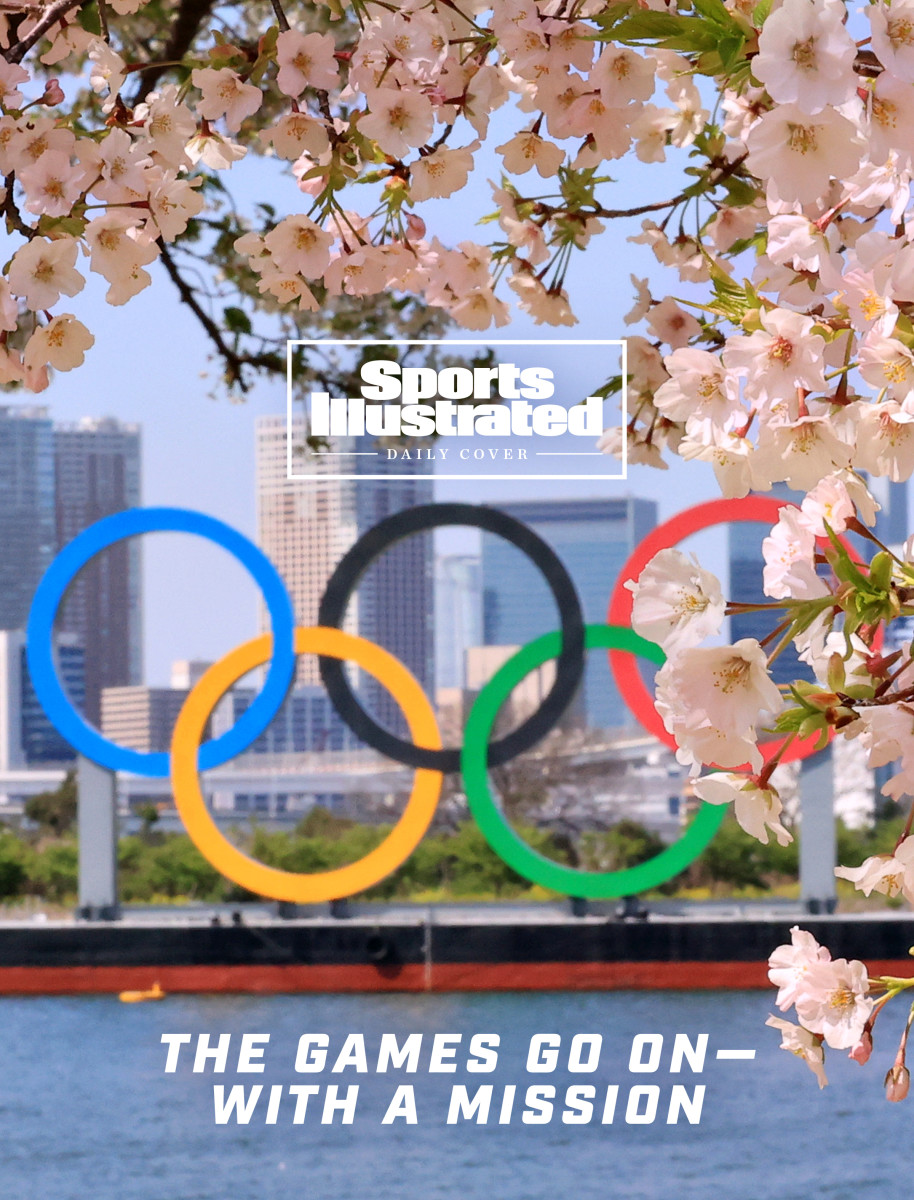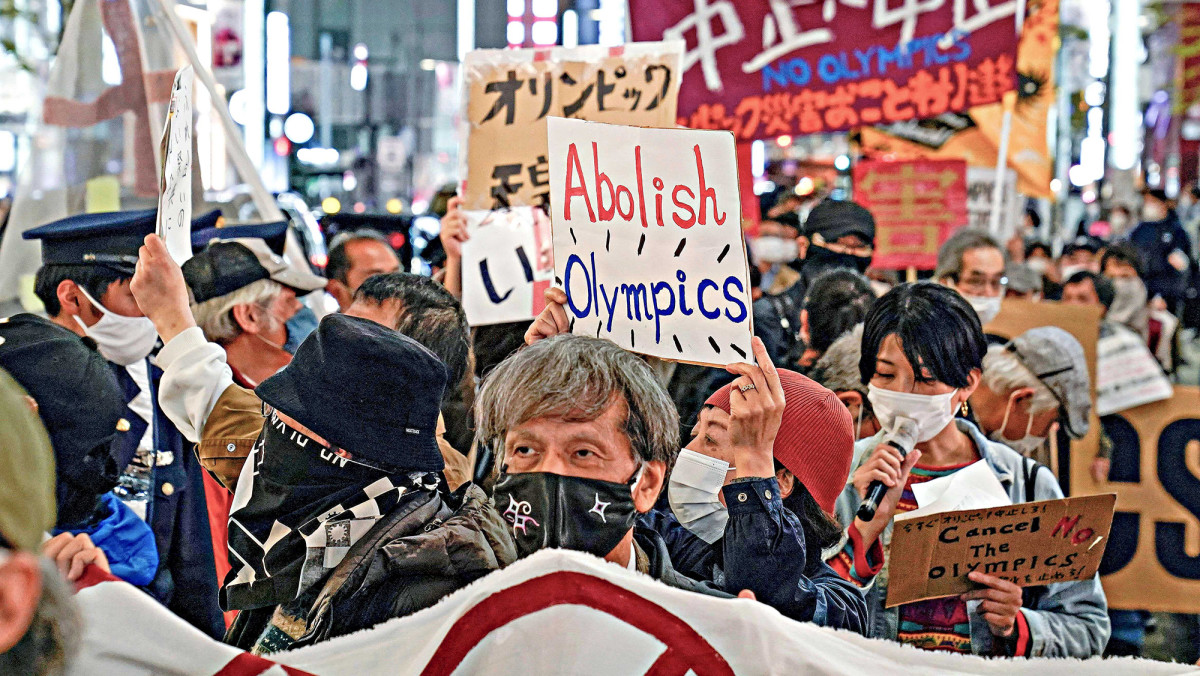The Games Go On—With a New Purpose
Sign up for our free daily Olympics newsletter: Very Olympic Today. You'll catch up on the top stories, smaller events, things you may have missed while you were sleeping and links to the best writing from SI’s reporters on the ground in Tokyo.
On July 23, the opening ceremony of the Tokyo Summer Olympics should resemble previous iterations in pomp, if not circumstance. There will be athletes marching, thousands of dreams fulfilled. And, of course, there will be choreographed pageantry, staged for a global TV audience that could use a little comfort amid a relentless pandemic.
The millions tuning in will see more than mere ceremony at that precise moment. They’ll know that the Tokyo Games—already the first to be postponed since the modern Olympic era began 125 years ago—will actually take place, despite protests, petitions and months of hand-wringing. Viewers will observe a backdrop without precedent, with masks covering faces and the stands, devoid of spectators.

The Olympians likely won’t care at that point that nothing like these Games has ever been staged. They’ll look to seize the opportunity for glory that vanished in 2020. The Tokyo Games will feature Simone Biles contorting her way toward yet more gymnastics history, Katie Ledecky swimming to add to her medal haul, Megan Rapinoe and the U.S. women’s soccer team looking for revenge after coming home from Rio empty-handed, Diana Taurasi hunting a fifth basketball gold, and Allyson Felix gracing the track at her fifth (and last) Games.
Much of the focus in the lead-up lingered on whether the Games should be staged now, especially in a country with both a recent upswing in COVID-19 rates and a low vaccination rate. But there’s no longer any question that they’re happening. So the emphasis must shift to how the Pandemic Olympics can be held most safely—and whether it can provide much-needed relief to a planet of sports fans still weary even as things inch back toward normalcy.
Once the events begin, it should be easier to identify with the athletes. Between Olympians and Paralympians, more than 15,000 elite competitors had to pause their lives. Again. Many of them are amateurs. The vast majority are poorly compensated but incurred another 12 months of training expenses—for a year of training they thought they had already completed. They postponed weddings, college enrollments, plans to conceive and more lucrative burgeoning careers. The top competitors could not capitalize on the sponsorship opportunities that always follow golden performances. Nor could they bank bonus money for medals that often help fund their future plans.
Of course, these athletes heard all the complaints directed at the International Olympic Committee: new virus strains that could spike positive cases in the host country, myriad polls showing the majority of Japanese citizens favored postponement or cancellation of the Games and nine prefectural governors who publicly agreed with that view. Plus, there were the concerns voiced by the medical workers’ union, whose members worried about overcrowded hospitals, which were already running out of beds, and the safety of overworked doctors and nurses.

Of course, many athletes sympathized. They had been impacted themselves by COVID-19. Some trained in underdeveloped countries that had been crushed by the pandemic. But if they chose not to compete, someone else would.
That led experts like Dr. Robby Sikka to consider best-case scenarios as opposed to worst-case ones. The Timberwolves’ vice president of basketball performance and technology and a member of the NBA’s sports science committee, Sikka joined a U.S.-based group of representatives from across pro sports at the start of the pandemic. They met regularly by videoconference with the CDC and the White House, sharing information and data on what worked and what did not.
They’re now the COVID-19 Sports and Society Workgroup, and when they look at the Olympics, they see the best hope lying in Tokyo’s bubble. It more closely resembles the model used for the NCAA men’s basketball tournament than the NBA’s version, which Sikka helped create. College teams stayed in Indianapolis with their movement restricted, underwent regular testing and didn’t interact with family, friends or spectators. Only one tournament game was canceled.
As for what the NBA and NCAA experiences can teach Olympic organizers, Sikka points out that creating a bubble environment is much harder than maintaining it. “Get people in and safe and pull out the positive cases up front—if you do that, then you give yourself a chance,” he says. “If you don’t, then nothing else really matters.”
Sikka points to three significant differences from 2020 compared with now:
• New, highly contagious variants that register higher viral loads than anything doctors saw last fall or last summer.
• Higher positive rates for younger populations. In Minnesota, where Sikka lives, the average age of patients hospitalized with COVID-19 last summer was 72; this spring, it was 57.
• The long-term unknowns, as in the case of Olympians who caught COVID-19 before and might still be impacted by it. “Even a 1% or 2% deficit in performance for an Olympic athlete can be really, really significant,” Sikka says. “But it underscores why it’s so important to set up a safe bubble.”
As of now, plans for Tokyo include daily testing, eating meals two meters apart and masks worn at all times. Sikka’s bubble would include, in an ideal world, daily PCR testing, having as many athletes and officials as possible vaccinated, and eliminating interactions with anyone outside of whatever sealed-off environment exists. The degree to which Olympic teams follow those guidelines will likely present a competitive advantage, says Sikka, who has been advising USA Basketball for the Games. “You have to wonder how the disparity in vaccination rates will impact training in countries hit harder, or where athletes aren’t able to train for their once-in-a-lifetime chance,” he says. “That shapes how I’m going to watch the Olympics, and it should shape how we’re going to evaluate what we really get out of those weeks.”
He doesn’t mean that in a negative sense, necessarily, but more in a rare one. It will be impossible to judge the Tokyo Games by normal metrics in such abnormal times. Of course, athletes, their coaches and their countries want, more than anything, to win. The IOC will not have to pay back the roughly $4 billion a cancellation would have forced it to refund in TV money. NBC will keep the $1.25 billion it said it sold for Olympic advertising. One widely circulated quote, attributed to NBCUniversal CEO Jeff Shell, from a June conference for investors, spoke volumes. Tokyo, he said, “could be our most profitable Olympics in the history of the company.”
Sikka ponders more pertinent questions, or at least more human ones: “How can we justify it? How can we use this as a way to bring countries together?”

He then posits a 2020–21 twist on the Olympic ideal. The Games can show people from every corner of the globe that everyone who wants a vaccine needs access to it. Fans who aren’t vaccinated could receive their first shots on the way out of venues. The protocols put in place by the IOC can effectively mitigate risk, keeping competitions on schedule and athletes, officials and spectators safe.
As Sikka watched the French Open unfold in June, his thoughts drifted to Tokyo. Though tere were fans in the stands, they appeared emptier than expected, and sometimes it seemed like the players didn’t quite know what to make of the experience. He read how some elite players had chosen to skip these Olympics, preferring to wait until 2024 so that their families could participate in person. Not everybody had that choice. But the ones who decided to go and who won could highlight why it mattered. They could show that they’re more than a gold medalist; they’re an advocate for public health, for their communities, for a divided world that could use a unifying message.
“I hope the Olympics help us get over the pandemic and take a step forward,” Sikka says. “Because last year we couldn’t have them, and this is something we should be proud of. Now, we’ve got to make it so that the next thing is possible.”
In April, the Japanese government declared a state of emergency in urban areas, requiring restaurants that serve alcohol or offer karaoke to close, shuttering movie theaters and banning crowds at sporting events. In June, officials partially lifted the emergency state in Tokyo and other cities, after a drop in positive cases of 48%. Plans were instituted for a limited number of fans from Japan to attend the Games. But earlier this month, they flip-flopped again as cases spiked. The government declared a state of emergency in Tokyo, banning spectators and requiring bars and restaurants to close early.
In June, the IOC said that more than 80% of Olympic athletes had been or would be vaccinated before arriving in Tokyo. Organizers also decided to allow local spectators but cap attendance at 10,000 total or 50% of capacity, whichever number is smaller. Sikka hopes they’re placed far enough away from athletes.
Patience will be necessary, as complications are sure to arise. Already at least three athletes in the Olympic Village have tested positive. Athletes at the Games will be subjected to six times as many tests as NFL players underwent. Pro football had positives and false positives but, Sikka notes, the league “found a way to keep moving forward.”
All of which reminds the doctor of a commencement speech he heard in 2004. Sikka sat with his graduating Penn classmates as the speaker, Bono, called on their generation to advocate for poor and developing parts of the world. Sikka says it still resonates with him 17 years later.
And so he sees these unprecedented, potentially dangerous Tokyo Olympics presenting an opportunity, a chance to leave a collective legacy that’s far bigger than any individual one.
More Olympics Coverage:
• Caeleb Dressel Is a Swimming Machine
• What Are the COVID-19 Protocols Really Like?
• A Guide to the Five New Olympic Sports
